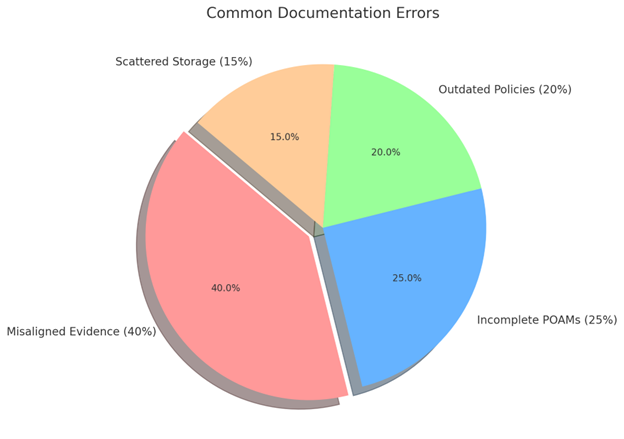Why Documentation is Critical: Making Assessors' Jobs Easier for Faster Certification
Introduction
Documentation is the backbone of the CMMC (Cybersecurity Maturity Model Certification) process. Without clear, organized, and complete documentation, your chances of passing an assessment are slim. Yet many businesses underestimate how critical it is to have evidence properly prepared and aligned with CMMC requirements.
This blog dives into why documentation is so crucial, how to organize it effectively, and tools like GRC (Governance, Risk, and Compliance) platforms that can streamline the process. By the end, you’ll understand how solid documentation not only makes assessors’ jobs easier but also speeds up your path to certification.
The Role of Documentation in CMMC Compliance
CMMC assessments require you to demonstrate that your organization meets specific security controls across multiple domains. Documentation serves as the primary evidence assessors rely on to verify compliance.
Why Assessors Care About Documentation
- Proof of Compliance: Policies, procedures, and records show how controls are implemented.
- Efficiency: Well-organized documentation reduces the time needed to review evidence.
- Trustworthiness: Properly maintained records establish credibility with assessors.
Types of Documentation Required for CMMC Compliance
Every CMMC level has specific documentation requirements. Below is an overview of the most critical documents assessors will expect:
Document | Purpose |
Describes your system architecture, controls, and implementation details. | |
Plan of Action and Milestones (POAM) | Outlines gaps in compliance and steps to address them. |
Policies and Procedures | Provides evidence of how controls are implemented and managed. |
Access Control Records | Tracks who has access to systems handling CUI. |
Incident Response Plan | Details how your organization responds to security incidents. |
Audit Logs | Documents activity within your network to prove monitoring and auditing are in place. |
Common Documentation Challenges
Despite its importance, many organizations struggle with documentation.
1. Lack of Organization
- Evidence is scattered across multiple systems or departments.
- Policies and procedures are outdated or incomplete.
2. Misaligned Evidence
- Documentation doesn’t directly map to CMMC controls or objectives.
- Critical gaps exist, such as missing incident response plans or incomplete POAMs.
3. Time-Consuming Processes
- Collecting, organizing, and updating documentation is labor-intensive without proper tools.
How to Organize Documentation for CMMC Success
1. Map Evidence to CMMC Controls
Each control within the CMMC framework has specific objectives. Create a checklist to ensure your documentation addresses these objectives directly.
Control Example | Required Documentation |
Access Controls (AC) | User access policies, access logs, and system permissions records. |
Incident Response (IR) | Incident Response Plan, incident reports, and resolution timelines. |
2. Use a Centralized Storage System
Store all compliance-related documents in a single location, such as a secure GRC tool. This makes it easy to access and update evidence as needed.
3. Update Regularly
CMMC compliance is not a one-time effort. Regularly review and update policies, procedures, and evidence to reflect current practices and security requirements.
GRC Tools: Streamlining Documentation Management
Governance, Risk, and Compliance (GRC) platforms simplify the process of organizing and maintaining documentation.
How GRC Tools Help with Documentation
- Centralized Storage: Keeps all documents in one secure, easy-to-access location.
- Automated Mapping: Links evidence directly to CMMC controls, eliminating guesswork.
- Real-Time Updates: Tracks changes and updates in real-time, ensuring your documentation is always current.
- Audit Trails: Provides detailed logs of who accessed or updated documents, increasing accountability.
Visual: Pie Chart – Common Documentation Errors

- Misaligned Evidence (40%)
- Incomplete POAMs (25%)
- Outdated Policies (20%)
- Scattered Storage (15%)
Case Study: Streamlining Documentation for a Mid-Sized Contractor
Scenario: A defense contractor with 300 employees struggled to manage compliance documentation across multiple departments. Evidence was scattered, and key documents were outdated.
Solution:
- Implemented a GRC tool to centralize and map evidence.
- Conducted a thorough review to align documentation with CMMC controls.
- Trained employees to update records regularly.
Result:
- Reduced preparation time by 50%.
- Passed the CMMC Level 2 assessment on the first attempt.
Pro Tips for Documentation Success
- Train Your Team: Ensure all staff understand the importance of accurate documentation and their role in maintaining it.
- Incorporate Timestamps: Use dated screenshots and records to prove the timing of compliance efforts.
- Conduct Internal Audits: Periodically review your documentation to identify and address gaps before assessments.
Conclusion: Why Documentation Matters
Clear, organized, and complete documentation is critical for passing your CMMC assessment. It demonstrates your organization’s commitment to compliance, speeds up the assessment process, and reduces the risk of costly re-assessments.
Take control of your compliance journey with the right tools and strategies.
📅 Book Your Free Demo of our Compliance Assessment Tool today to see how we can simplify documentation management and help you achieve CMMC success.
